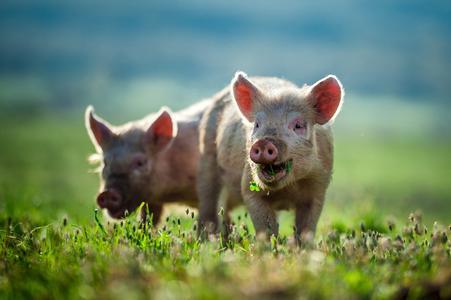Pigs and Squid: New Microbes Found this Month
Posted on May 3, 2023 by Clare Baker
In this month’s ‘New to Science’ we have an array of aerobic microbes that were found all over the world in soil, brains and rice.
Our first bacterium was isolated from the Kumtag Desert in China. Aridibaculum aurantiacum is not just a novel species but belongs to a novel genus within the family Chitinophagaceae. The family Chitinophagaceae includes 49 published genera which are found across various habitats such as soil, sediment and other niches. A. aurantiacum is rod shaped and isolated from arid soil. It comes as no surprise then that their name, Aridibaculum, comes from aridus, meaning ‘dry’ and bacculum, meaning ‘rod’, and the literal naming doesn’t stop there. Their species name, aurantiacum, refers to the orange colour of the bacterium when grown in agar.

Our next microbe also lives in Chinese soil, but to find it we need to head to a pig farm. While exploring the microbial diversity of pig farms in Guangdong, a province in south-eastern China, researchers discovered a novel gram-negative, aerobic, rod-shaped bacterial strain. It joins the genus Tahibacter, which has recently been moved to the newly established family Rhodanobacteraceae. These researchers also went down the literal route when naming this novel bacterium, Tahibacter harae, where ‘harae’ originates from the word ‘ha'rae’ referring to a pigsty. T. harae may have emerged from new ecological niches created due to antibiotic residues in the soil and water thanks to intensive animal husbandry practices. It is thought that antibiotic residues from pig farms may affect the structure and function of the soil microbial community as the antibiotics given to the pigs cannot be completely decomposed and instead remain in the natural environment.
There is definitely a soil theme emerging this month, as our next bacterium was isolated from the rhizosphere of cotton plant roots. For those who don’t know, the rhizosphere is the soil surrounding the root of a plant. The microbes surrounding the root are affected by the compounds released by the plant and make up a specific community – a microbiome. This community of microbes is where we find our next two novel bacteria, Actinophytocola gossypii and Streptomyces gossypii. A. gossypii joins 10 other species in the genus Actinophytocola which have been isolated from a range of habitats such as desert soil, marine sediment and plant rhizospeheres. S. gossypii joins the genus Streptomyces alongside 16 other species. This genus serves as a reservoir for a broad range of secondary metabolites, notably antibiotics. They both get their species name, ‘gossypii’ from the cotton genus ‘Gossypium’.
Moving from one white plant product to another, we find the novel bacteria Spirosoma oryzicola. This bacterium was isolated from a dried rice husk, the hard protective covering of rice, sampled from Yeoju-si, Gyeonggi-do, Republic of Korea. The bacterium joins 44 other species in the genus Spirosoma isolated from soil and fresh water.
We’re finishing this week with something a bit freaky. Lolliginicoccus levis is a new bacterium isolated from the brain of a Chiroteuthis picteti squid. This poor squid became stuck at a depth of 374 metres in a deep seawater pumping facility in Muroto City, Kōchi, Japan. Not only had the squid been stuck for two days in the facility, but each part of the squid was then mushed or cut into small pieces. Researchers have not only assigned L. levis to a brand-new genus, but have also reclassified two other species which previously belonged to the genus Hoyosella. The two previously discovered species, Lolliginicoccus suaedae and Lolliginicoccus lacisals will join L. levis in the genus Lolliginicoccus.

